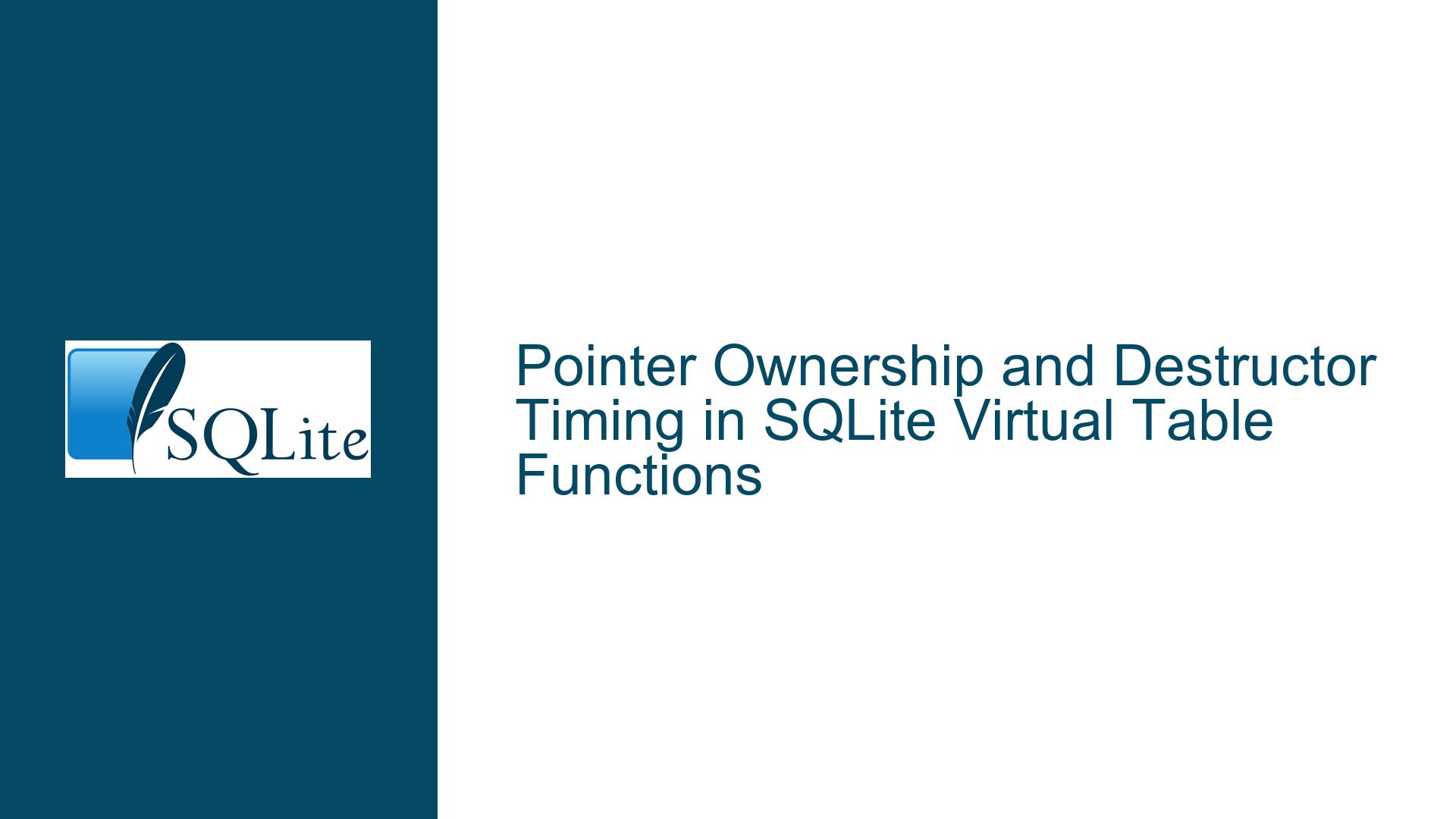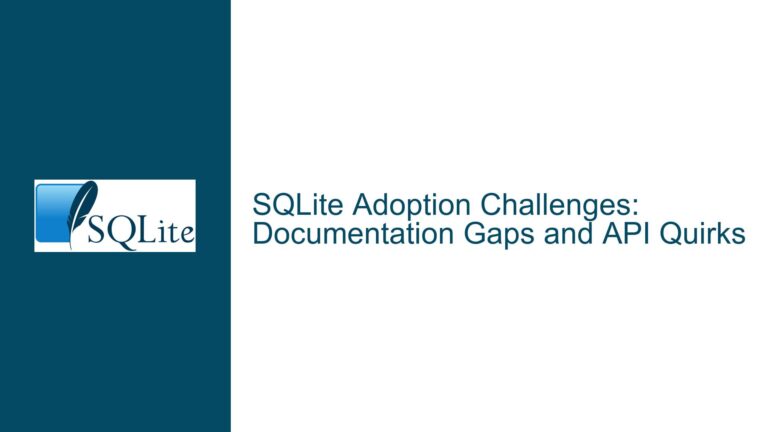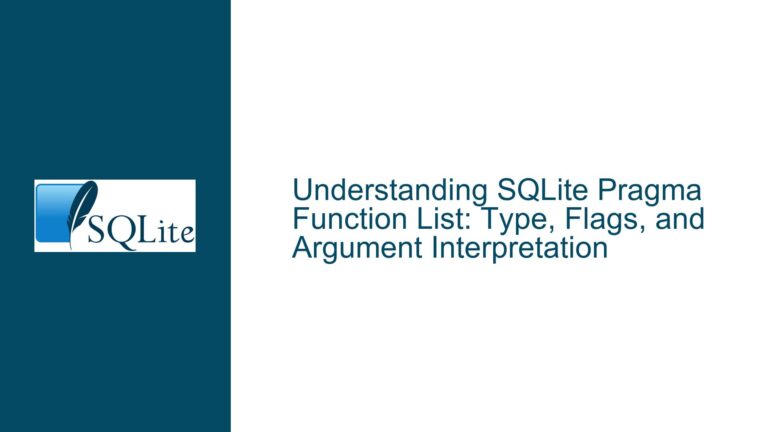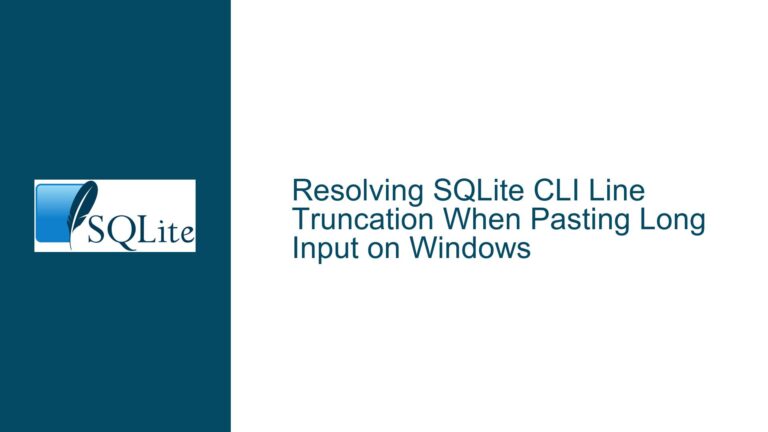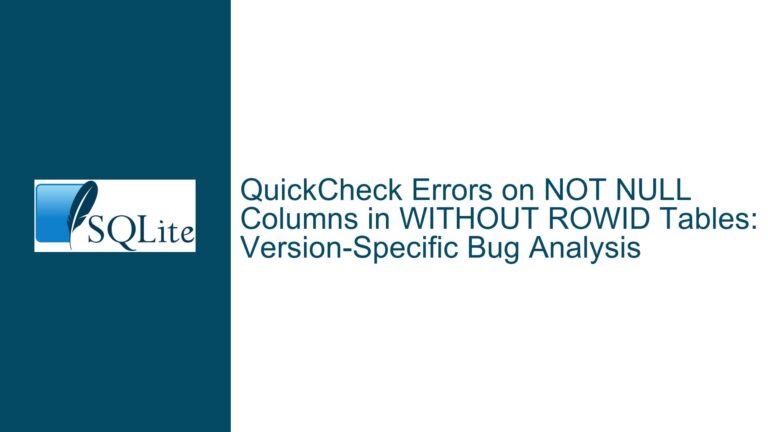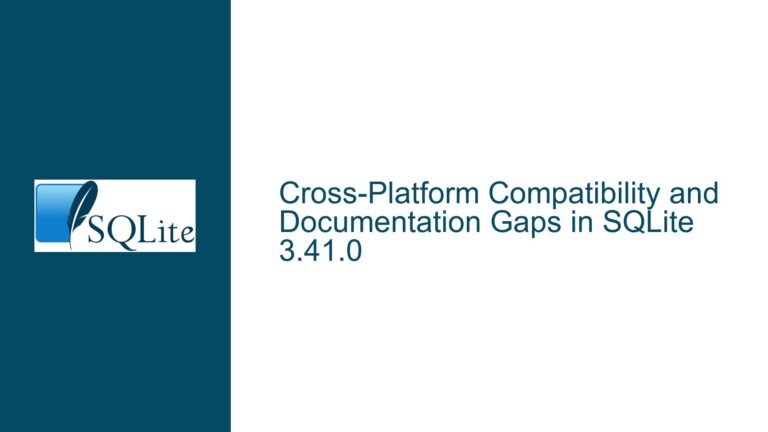Pointer Ownership and Destructor Timing in SQLite Virtual Table Functions
Understanding Pointer Lifetime Management in Virtual Table Column Extraction and Function Execution
The core issue revolves around the ownership semantics of pointers passed via SQLite’s pointer passing interface when used in conjunction with virtual tables and scalar functions. A developer observed unexpected timing in the invocation of a pointer’s destructor (release_record) relative to the execution of a scalar function (lioli_binary) that consumes the pointer. Initial observations suggested that the destructor was called before the function processed the pointer, but corrected logging confirmed the destructor runs after the function. Despite this correction, ambiguity remains about how SQLite manages pointer ownership and lifetime guarantees in virtual table queries.
This problem arises when a virtual table’s xColumn method uses sqlite3_result_pointer() to return a pointer to a row’s column data, paired with a destructor. A scalar function (e.g., lioli_binary) is then applied to that pointer in a query. The execution plan’s structure implies that the pointer is valid during the function’s execution, but the timing of the destructor’s invocation raises questions about when the application is permitted to release resources associated with the pointer.
Key entities involved:
- Virtual Table (
origin): A custom table implementing thexColumnmethod to return pointers. - xColumn Method: Invoked during
VColumnopcode execution to populate column values. sqlite3_result_pointer(): API function binding a pointer to a query result, with an optional destructor.- Destructor (
release_record): Callback invoked by SQLite to release the pointer. - Scalar Function (
lioli_binary): User-defined function processing the pointer. - Query Execution Plan: SQLite’s bytecode illustrating the order of operations for
SELECT lioli_binary(lioli) FROM origin LIMIT 30;.
The confusion stems from SQLite’s documentation, which states that pointer ownership generally remains with the application (§4) but allows for ownership transfer to SQLite in specific contexts (§3.2). The developer’s use case tests these boundaries, as the pointer appears to be released (via the destructor) immediately after the scalar function completes, implying SQLite assumes temporary ownership during query execution.
Root Causes: Destructor Triggering Logic and Ownership Semantics Misalignment
1. Misinterpretation of Pointer Ownership Transfer Conditions
SQLite’s pointer passing interface distinguishes between binding pointers (e.g., sqlite3_bind_pointer()) and returning pointers (e.g., sqlite3_result_pointer()). The documentation’s §3.2 refers primarily to bound pointers (parameters), where SQLite may take ownership if a destructor is provided. In contrast, §4 applies to result pointers, where ownership remains with the application unless explicitly transferred.
In the virtual table scenario, sqlite3_result_pointer() is used in the xColumn method, which falls under result pointer semantics. The destructor here is not a transfer of ownership but a notification mechanism for when SQLite no longer needs the pointer. However, the timing of this notification depends on SQLite’s internal value management, which is not immediately obvious.
2. Value Lifetimes in Prepared Statement Execution
SQLite’s bytecode engine (as shown in the EXPLAIN output) processes values in a way that may release them as soon as they are no longer needed. The ReleaseReg opcode (step #10) indicates that the register holding the pointer is cleared after the function call (step #9). This triggers the destructor if the pointer’s reference count drops to zero. However, the scalar function (lioli_binary) might internally retain the pointer beyond its apparent scope, leading to use-after-free risks if the destructor releases resources prematurely.
3. Virtual Table and Function Execution Order Ambiguities
The xColumn method is called during the VColumn opcode (step #8), which retrieves the pointer and binds it to a register. The function lioli_binary (step #9) consumes this register, after which ReleaseReg (step #10) decrements the pointer’s reference count. If the scalar function does not increment the reference count, the destructor fires immediately. This creates an illusion of ownership transfer, but in reality, SQLite is merely managing the pointer’s lifetime within the current query context.
4. Inconsistent Application-Database Lifecycle Coordination
The application may assume that the pointer is valid indefinitely unless explicitly released, while SQLite’s destructor invocation suggests otherwise. This mismatch arises when the virtual table’s xColumn method returns pointers to transient data structures (e.g., lioli) that the application expects to manage independently. Without explicit ownership transfer, the destructor’s invocation timing becomes critical.
Resolution Strategy: Ensuring Pointer Validity Across Query Execution Stages
Step 1: Validate Pointer Lifetime Requirements
- Audit the
lioliData Structure: Confirm whetherlioliis intended to outlive the query or is transient. If transient, ensure the destructorrelease_recorddoes not invalidate the pointer beforelioli_binarycompletes. - Review Scalar Function Implementation: Verify that
lioli_binarydoes not retain the pointer beyond its invocation. If it does, SQLite’s destructor will conflict with the function’s internal usage.
Step 2: Align Pointer Handling with SQLite’s Ownership Model
- For Application-Owned Pointers: Omit the destructor in
sqlite3_result_pointer(), as §4 dictates ownership remains with the application. Ensure the application manually manages the pointer’s lifetime. - For SQLite-Owned Pointers: Use
sqlite3_bind_pointer()with a destructor when passing pointers as parameters, adhering to §3.2. This transfers ownership to SQLite, which will invoke the destructor after the pointer is no longer needed.
Step 3: Instrument Destructor and Function Calls
- Add Logging to Critical Paths:
void release_record(void *ptr) { log("Destructor invoked for pointer %p", ptr); // Actual cleanup logic }void lioli_binary(sqlite3_context *ctx, int argc, sqlite3_value **argv) { void *ptr = sqlite3_value_pointer(argv[0], "wt.software/lioli"); log("lioli_binary processing pointer %p", ptr); // Function logic }Cross-reference logs to confirm the destructor runs after
lioli_binaryexits.
Step 4: Adjust Pointer Retention with Reference Counting
- Increment Reference Count Before Returning the Pointer:
void xColumn(sqlite3_vtab_cursor *cur, sqlite3_context *ctx, int i) { CustomCursor *c = (CustomCursor *)cur; retain_lioli(c->lioli); // Application-defined refcount increment sqlite3_result_pointer(ctx, c->lioli, "wt.software/lioli", release_record); }void release_record(void *ptr) { if (decrement_refcount(ptr) == 0) { // Application-defined refcount decrement free_lioli(ptr); } }This ensures the pointer remains valid until all references are released.
Step 5: Utilize SQLite Auxiliary Data for Extended Lifetimes
- Bind the Pointer as Auxiliary Data:
void xColumn(sqlite3_vtab_cursor *cur, sqlite3_context *ctx, int i) { CustomCursor *c = (CustomCursor *)cur; sqlite3_set_auxdata(ctx, 0, c->lioli, release_record); sqlite3_result_pointer(ctx, c->lioli, "wt.software/lioli", NULL); }Auxiliary data is destroyed when the statement completes or the auxiliary data slot is overwritten, offering finer control.
Step 6: Clarify Documentation Interpretation
- Bound vs. Result Pointers: Emphasize that §3.2 applies to pointers passed into SQLite (e.g.,
sqlite3_bind_pointer()), while §4 governs pointers returned from SQLite (e.g.,sqlite3_result_pointer()). Destructors for result pointers are notifications, not ownership transfers. - Virtual Table Best Practices: Recommend using auxiliary data or reference counting for pointers returned by virtual tables to avoid reliance on destructor timing.
Step 7: Analyze Query Execution Plans for Context
- Map Opcode Sequencing: Use
EXPLAINto identify whenVColumn,Function, andReleaseRegopcodes execute. In the provided plan,ReleaseReg(step #10) followsFunction(step #9), indicating the pointer is released immediately after the function call. This necessitates ensuring the pointer remains valid until the function completes.
Step 8: Test with Delayed Destructor Invocation
- Simulate Long-Running Functions: Introduce artificial delays in
lioli_binaryto test whether the destructor is called prematurely. If the destructor fires during the delay, it indicates incorrect ownership semantics.
Step 9: Leverage Debug Hooks for Pointer Tracking
- Enable SQLite’s Debug APIs: Use
sqlite3_config(SQLITE_CONFIG_LOG, ...)to trace pointer registration and destructor calls. Cross-reference these logs with application-level logging.
Step 10: Adopt Conservative Pointer Management
- Assume SQLite May Release Pointers Immediately: Design the application to treat pointers as valid only within the scope of the function or query where they are used. For cross-query retention, implement explicit reference counting or duplication.
By methodically applying these steps, developers can reconcile SQLite’s pointer ownership semantics with their application’s resource management logic, ensuring pointers remain valid throughout their required lifetimes and destructors fire at the correct time.
